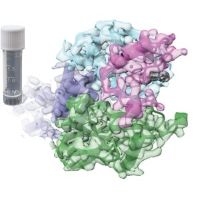Specification
| Description | Recombinant protein from the full-length sequence of homo sapiens Pim-3 proto-oncogene, serine/threonine kinase (PIM3) (NM_001001852). |
| Organism | Homo sapiens (Human) |
| Expression Host | Human Cells |
| Tag Info | His or DYKDDDDK. Please contact us if you need further information or require specific designed tag. |
| Purity | Greater than 90% by SDS-PAGE gel |
| Uniprot ID | Q86V86 |
| Entry Name | PIM3_HUMAN |
| Gene Names | PIM3 |
| Alternative Gene Names | |
| Alternative Protein Names | Serine/threonine-protein kinase pim-3 (EC 2.7.11.1) |
| Application | Antigens, Western, ELISA and other in vitro binding or in vivo functional assays, and protein-protein interaction studies; For research & development use only! |
| Buffer | Purified protein formulated in a sterile solution of PBS buffer, pH7.2, without any preservatives |
| Endotoxin | Endotoxin level is < 0.1 ng/µg of protein (<1EU /µg) |
| Length | 326 |
| Molecular Weight(Da) | 35891 |
| Protein Sequence | (The sequence of expressed protein may have some variation from the sequence shown below. Please contact us for the exact sequence.) MLLSKFGSLAHLCGPGGVDHLPVKILQPAKADKESFEKAYQVGAVLGSGGFGTVYAGSRIADGLPVAVKHVVKERVTEWGSLGGATVPLEVVLLRKVGAAGGARGVIRLLDWFERPDGFLLVLERPEPAQDLFDFITERGALDEPLARRFFAQVLAAVRHCHSCGVVHRDIKDENLLVDLRSGELKLIDFGSGALLKDTVYTDFDGTRVYSPPEWIRYHRYHGRSATVWSLGVLLYDMVCGDIPFEQDEEILRGRLLFRRRVSPECQQLIRWCLSLRPSERPSLDQIAAHPWMLGADGGVPESCDLRLCTLDPDDVASTTSSSESL |
Background
| Function | FUNCTION: Proto-oncogene with serine/threonine kinase activity that can prevent apoptosis, promote cell survival and protein translation. May contribute to tumorigenesis through: the delivery of survival signaling through phosphorylation of BAD which induces release of the anti-apoptotic protein Bcl-X(L), the regulation of cell cycle progression, protein synthesis and by regulation of MYC transcriptional activity. Additionally to this role on tumorigenesis, can also negatively regulate insulin secretion by inhibiting the activation of MAPK1/3 (ERK1/2), through SOCS6. Involved also in the control of energy metabolism and regulation of AMPK activity in modulating MYC and PPARGC1A protein levels and cell growth. {ECO:0000269|PubMed:15540201, ECO:0000269|PubMed:16818649, ECO:0000269|PubMed:17270021, ECO:0000269|PubMed:17876606, ECO:0000269|PubMed:18593906}. |
| Pathway | |
| Protein Families | Protein kinase superfamily, CAMK Ser/Thr protein kinase family, PIM subfamily |
| Tissue Specificity | Detected in various tissues, including the heart, brain, lung, kidney, spleen, placenta, skeletal muscle, and peripheral blood leukocytes. Not found or barely expressed in the normal adult endoderm-derived organs such as colon, thymus, liver, or small intestine. However, expression is augmented in premalignant and malignant lesions of these organs. {ECO:0000269|PubMed:15540201, ECO:0000269|PubMed:16818649, ECO:0000269|PubMed:17270021}. |
QC Data
| Note | Please contact us for QC Data |
| Product Image (Reference Only) |  |

